The History of St George
About our founding, stained glass windows and banners
St. George Day:
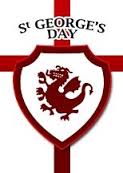 Saint George’s Day is the feast day of Saint George as celebrated by various Christian Churches and by the several nations, kingdoms, countries, and cities of which Saint George is the Patron Saint (See Wikipedia listing for St. George Day.)
Saint George’s Day is the feast day of Saint George as celebrated by various Christian Churches and by the several nations, kingdoms, countries, and cities of which Saint George is the Patron Saint (See Wikipedia listing for St. George Day.)
The History of St. George:
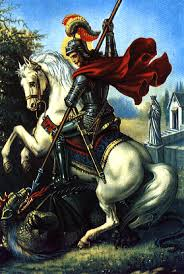 Saint George (AD 275–281 to 23 April 303), according to legend, was a Roman soldier and officer in the Guard of Roman Emperor Diocletian of the Roman army, who ordered his death for failing to recant his Christian faith. As a Christian martyr, he later became one of the most venerated saints in Christianity. In hagiography, as one of the Fourteen Holy Helpers and one of the most prominent military saints, he is immortalized in the story of Saint George and the Dragon. St. George has gone on to become the Patron Saint of the nation of England.
Saint George (AD 275–281 to 23 April 303), according to legend, was a Roman soldier and officer in the Guard of Roman Emperor Diocletian of the Roman army, who ordered his death for failing to recant his Christian faith. As a Christian martyr, he later became one of the most venerated saints in Christianity. In hagiography, as one of the Fourteen Holy Helpers and one of the most prominent military saints, he is immortalized in the story of Saint George and the Dragon. St. George has gone on to become the Patron Saint of the nation of England.
St George Episcopal Church grew out of a tent meeting. In October 1994, more than 200 eager Episcopalians responded to a newspaper notice and gathered in a tent to talk about establishing an Episcopal Church in The Villages. Because of the interest shown, a Mission Church was established and a priest appointed by the Bishop of Central Florida. Services began on the first Sunday of Advent 1994 in the Bingo Hall of Paradise Recreation Center. Our journey had begun.
The congregation soon outgrew the Paradise Center, and in March 1995, moved to a larger room in La Hacienda Recreation Center. In January 1996, nearly 90 members of this mission church traveled to Daytona Beach to attend the annual Convention of The Episcopal Diocese of Central Florida. During this convention, Bishop John Howe introduced our group to the Convention and announced that we had been accepted as a Parish of the Diocese. To be accepted as a Parish just slightly more than a year after we were designated a Mission is unheard of and probably set a record.
The Parish continued to grow, as did the retirement community in which we are located. And God continued to bless us. The Villages’ developer designed and built a church on Town Square, a beautiful cathedral-type structure. (This is the current Sharon Morse Performing Arts Center). The Church on the Square, Episcopal, held its first service in this building on Easter, March 30, 1997. Designed for 750 worshippers, more than 1,100 attended that first Sunday.
Although the Episcopal congregation and its first priest, Father Steve Raulerson, contributed to the design of The Church on the Square, it was paid for and thus owned by The Villages’ developer. The Episcopal congregation shared the building with a non-denominational service and other musical celebrations. We are grateful to the developer and to Abundant Life Ministries for allowing us to use this gorgeous edifice as the spiritual home of St. George Episcopal Church, a name we officially adopted at our annual Parish meeting in January 1998.
When Father Steve Raulerson left us, Father Bob Richardson served as Priest in Charge, while a Search Committee began its work. In less than a year the Committee found and called the Reverend Roger Miller, who became our rector in October 1998.
The developer allowed us to use The Church on the Square for nearly five years, enabling us to build an active congregation and become financially secure enough to support a building of our own. When that time came, a Building Committee was formed, and the project to build a new church began in the summer of 1999. A “Charrette” was held, to allow all members of St. George Parish to tell the Building Committee what they wanted in a church. A parcel of land on the corner of Paige Place and Avenida Central was purchased from The Villages’ developer, and an architect (John Dickerson) and building contractor (Clancey and Theys) were hired. A Capital Gifts Campaign was launched in October 2000, with the help of a professional fundraiser, nearly a million dollars was raised or pledged. A bank loan was secured, and the exciting development of our own home was underway. We broke ground on our property in March 2001 and craftsmen from around the state were brought in for the construction. The Amish of Lancaster County, Pennsylvania, came to build our pews and altar railings.
In May of 2002, Bishop John Howe dedicated and consecrated our new building and its contents, and St. George Episcopal Church, as we know it today, was born. It has become known as “the most beautiful church in the area,” and is a favorite “photo opportunity” for visitors and residents. However, St. George Episcopal Church is not just a beautiful building; it is the people who make up its congregation that make it great. We are grateful to the dedicated Episcopalians who had the vision to “plant” a church in The Villages. Our founding members, who along with those who came later, contributed and continue to contribute to its success.
In November of 2006, Father Roger Miller announced his retirement after 8 years of dedicated service to our community. The Diocese of Central Florida sent us Father Al Durrance as our interim pastor while our selection committee worked with the diocese to find us a new rector. Then in June 2007, Father Hugh P. Bromiley arrived from California and assumed the responsibility as the rector of St. George Episcopal Church.
In 2009, the appearance of our church changed with the expansion of the parish hall, a fresh coat of paint for the whole church and a 600 lb. cross from Ireland that stands in front of the new parish hall. The expansion of the hall, gave us a huge open space for all sorts of activities (parties, meetings, workshops & etc), a second conference room, a storage room and a full function professional kitchen.
In September 2013 Father Hugh Bromiley announced his retirement and The Reverend Canon Bill Squire was named Priest In Charge while the search committee and vestry called a new Rector for St. George. Father John Kelly from Albany, New York, assumed responsibility as our new rector and served the St. George community for over six years.
The hallmark of Fr. John Kelly’s tenure has been “growth.” Growth in parishioner membership, in outreach programs both locally and worldwide, in programs that benefit the membership and the surrounding community, and growth through the use of technology to spread the good news of Jesus Christ, our Savior.
Father John also guided us to enhance our worship and community service through beautiful music. In January 2018, a Capital Fund Campaign was launched to purchase a new organ for St. George. In less than 4 months $275,000 was raised for the St. George Episcopal Church Memorial Antiphonal Pipe Organ.
The Allen RL66a Organ was a significant enhancement to our music program. It is programmable and capable of replicating sounds of the great organs of the world. With this purchase, St. George has become a focal point of quality musical performances in the community.
Our music program includes all types of music–from traditional organ music to Gospel and folk to the delight of all who worship with us and who attend our concerts.
It has been – and continues to be – an exciting and inspiring experience for all of us who call ourselves “St. Georgians”, and who believe we can do “All Things Through Christ,” who strengthens us. We eagerly anticipate seeing where our journey takes us next.
Stained Glass Windows at St. George
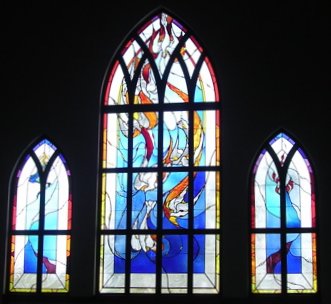
God the Holy Spirit
“God the Holy Spirit,” given by a group of people; Marie Balazs, in memory of her husband Frank; Bob Balfour, in memory of his wife Susi; Betty Brady and Jean Webb, in memory of Florence and Dr William Kessler; Merle Carter, in memory of Brud; June, Linda, and Laura Lee, in memory of Warren Lee and Annie Cooper Steen; Wrightson and Jeannette Lewis, in memory of Wrightson Walter Lewis; Don Lynn, in memory of Charles Gordon and Harriette J Lynn; and Jack and Pat Miller, in memory of Lt George B Browning. These two windows, along with the “God the Son” window behind the altar complete the Holy Trinity in the front of the church.
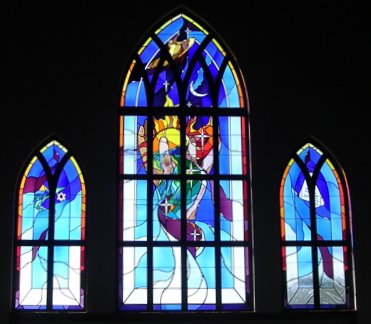
God the Father
There is a pattern to the large windows. The two transepts are “God the Father,” a special gift donated by Bud and Kay Morgan

Nativity
On the Gospel (left) side, the windows depict the life of Christ, beginning with The Nativity, donated by Betty Strand, in memory of her husband Rick, who was St George’s first organist.
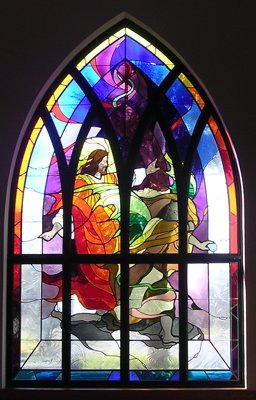
Temptations
The Temptations, given by Dorothy and Ken Smith in memory of loved ones.
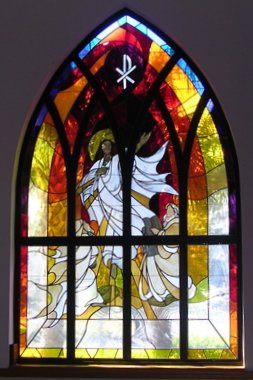
The Transfiguration
“The Transfiguration,” which was given “in honor of the wonderful people of St George” by a donor who wishes to remain anonymous.
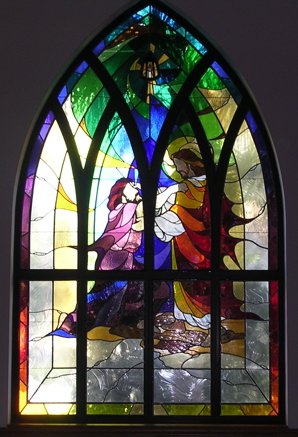
Healing
Jesus Healing the Blind Man, which was given by Gladys St Aubin in loving memory of her husband Roland, who was blind.
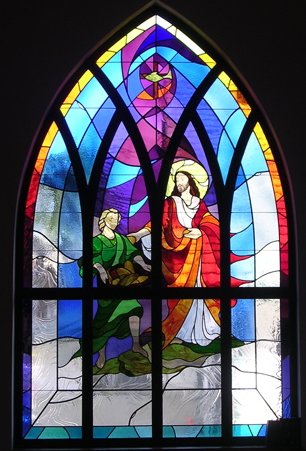
Miracle of the Fishes and the Loaves
“The Miracle of the Fishes and the Loaves,” which the Women’s Guild gave with the proceeds of the 2004 Bazaar.
Finally, there’s the magnificent “Second Coming of Christ,” which surrounds our front door. It was given by Dorothy Palen for her husband, Scott.
The four small windows – two on either side of the transept windows – were originally to be left clear glass. But they, too, were pledged, and were installed in late 2004. They depict “The Receiving of the Law” and The Exodus on the “God the Father” side; and Baptism and Pentecost on the “God the Holy Spirit” side. The windows were given by Betty Brady and Jean Webb in memory of their parents; by Wrightson and Jeannette Lewis in memory of their parents; and by Gert and Pat Worden, in memory of Bill Worden.
Designed and installed by the Lynchburg Glass Company in Virginia, the stained glass windows of St George Episcopal Church cost a total of $143,600 – every dollar donated by members of the St George congregation, in memory of or in honor of loved ones, and to the glory of God.
“I can’t believe we have come this far in just two and a half years,” said The Rev Roger Miller, St George rector, as the last of the 20 windows was installed in December 2004. “We have been truly blessed.”
Church of St. George Banner

One of the things that new members and visitors notice, is the Church of St. George Banner hanging in our church. The Following is the story behind this banner.
When our congregation was very young we had no name, and no fixed address. Our rector at the time helped with the plans for the proposed “Church on the Square”. We were there when ground was broken, and we had the privilege of moving into the new church when it was built. This became our first home, and we adopted its name. We even had a logo. Now in the 21st century, our membership has changed and our address changed. When in May of 2002 we moved into our own, newly constructed St. George Episcopal Church. The changes and growth have been remarkably. Therefore, it seems an opportune time to explain and update the meaning of the “Church of St. George Banner” for the present congregation.
 When the Vestry decided to procure a banner, they examined the possibility of our making it ourselves. And so we designed and made the red banner hanging on the west wall near to the pulpit. At its center is one of the sacred monograms of Jesus – a cross with IC, XC and NIKA in its arms. IC and XC are the contractions of IHCOYC and XPICTOC, Greek for Jesus Christ. The Greek word NIKA means Victor or Conqueror. Incidentally we put the cross in red to remind us of St. George, patron saint of England, the mother country of our denomination. We put this symbol of Christ in the heart of that of our congregation which was a blue cross on a beige background.
When the Vestry decided to procure a banner, they examined the possibility of our making it ourselves. And so we designed and made the red banner hanging on the west wall near to the pulpit. At its center is one of the sacred monograms of Jesus – a cross with IC, XC and NIKA in its arms. IC and XC are the contractions of IHCOYC and XPICTOC, Greek for Jesus Christ. The Greek word NIKA means Victor or Conqueror. Incidentally we put the cross in red to remind us of St. George, patron saint of England, the mother country of our denomination. We put this symbol of Christ in the heart of that of our congregation which was a blue cross on a beige background.
 At the bottom of the banner is the Episcopal shield. This has the cross of St. George, a red upright cross on a white background. In the upper left corner of the shield, a diagonal cross on a blue background, the cross of St. Andrew, patron saint of Scotland. Where the first American Episcopal bishop was consecrated. This cross is made up of 9 crosslets, (each made of 4 crosslets) the nine representing the first 9 dioceses of the Episcopal Church.
At the bottom of the banner is the Episcopal shield. This has the cross of St. George, a red upright cross on a white background. In the upper left corner of the shield, a diagonal cross on a blue background, the cross of St. Andrew, patron saint of Scotland. Where the first American Episcopal bishop was consecrated. This cross is made up of 9 crosslets, (each made of 4 crosslets) the nine representing the first 9 dioceses of the Episcopal Church.
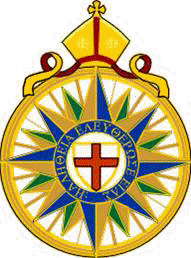 At the very top of the banner is the Compass Rose, symbol of the Anglican Communion. This was designed by an Episcopal priest. It consists of St. George’s shield at the center, surrounded by the Greek words meaning “The truth shall make you free.” From this radiates the points of the compass representing the world wide Anglican Communion, the major points gold and blue, the minor ones green and gold. Surmounting the Compass Rose is a bishop’s mitre, symbolizing episcopacy and apostolic succession.
At the very top of the banner is the Compass Rose, symbol of the Anglican Communion. This was designed by an Episcopal priest. It consists of St. George’s shield at the center, surrounded by the Greek words meaning “The truth shall make you free.” From this radiates the points of the compass representing the world wide Anglican Communion, the major points gold and blue, the minor ones green and gold. Surmounting the Compass Rose is a bishop’s mitre, symbolizing episcopacy and apostolic succession.
